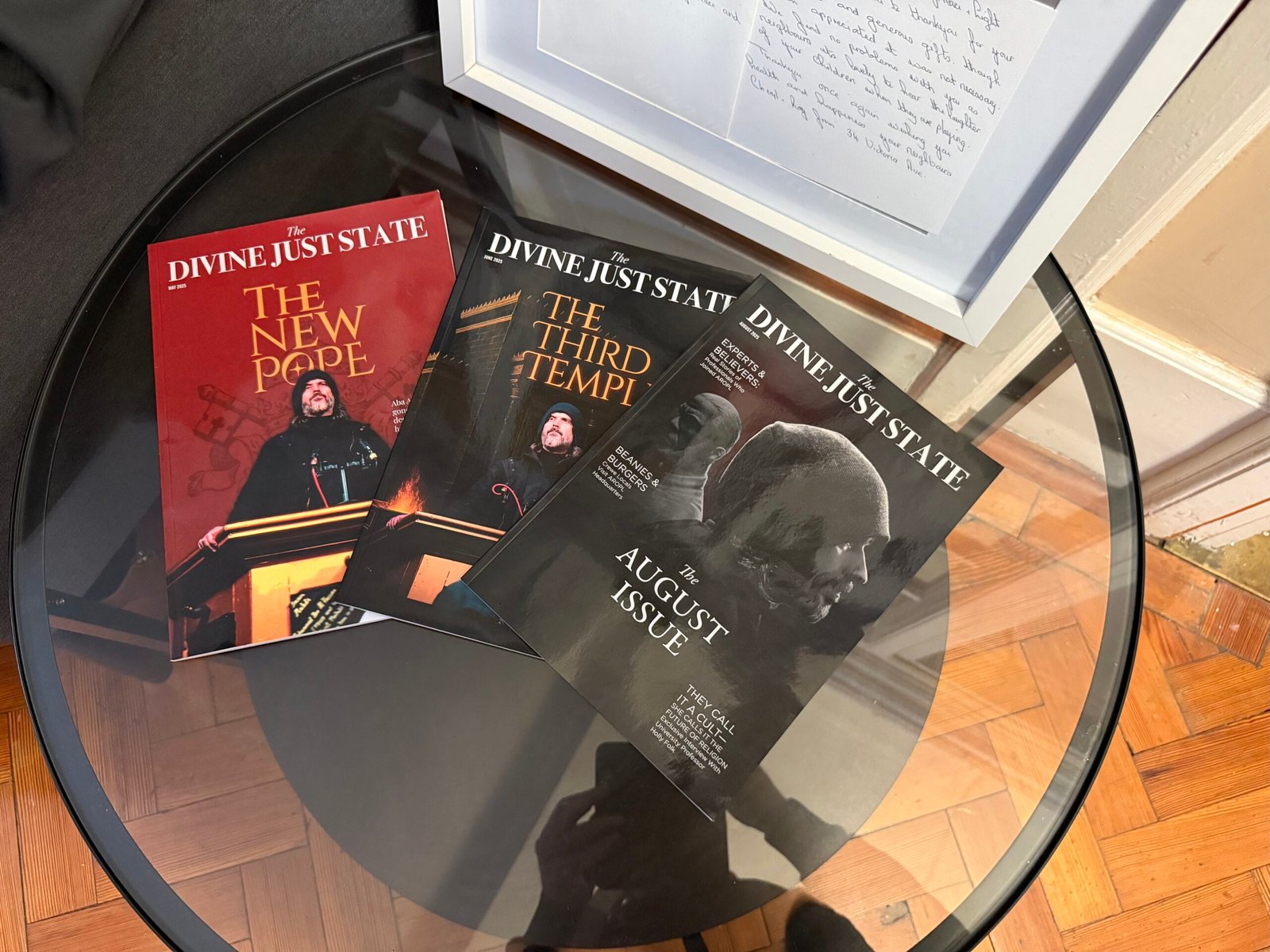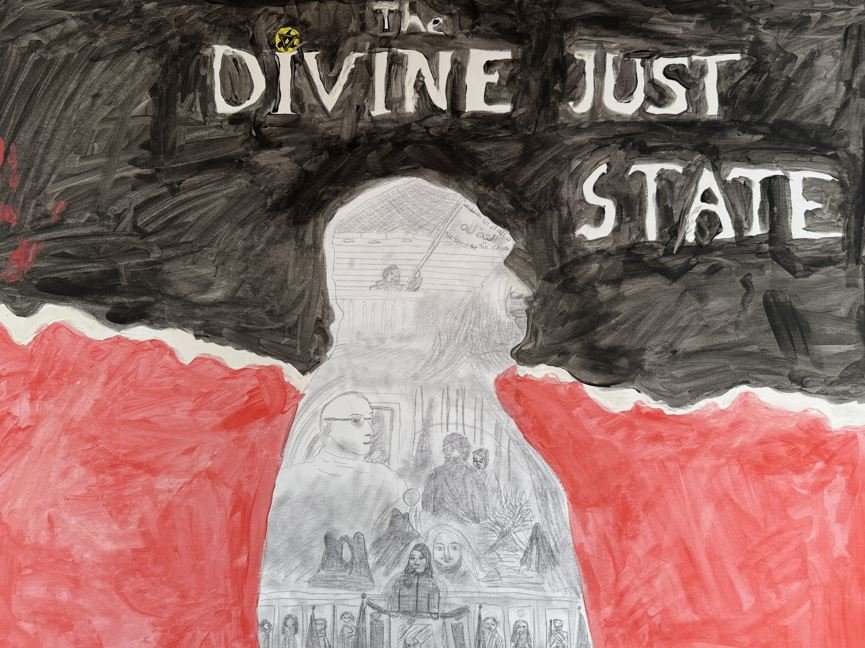The Ahmadi Religion of Peace and Light emphasizes the spiritual Greater Jihad. It admits the armed Lesser Jihad in limited, defensive cases.
by Márk Nemes
Article 2 of 2. Read article 1.

With the new millennium (in the Christian calendar’s calculation), Hashem, as the Mahdi of the Ahmadi Religion of Peace and Light (AROPL), aims to reemphasize a timeless and more internalized view of jihad. He knowingly separates the types of righteous struggles, outlining a clear distinction between the Greater and the Lesser forms. Importantly, he decontextualizes both original temporal and spatial elements, displacing jihad from the borderline of “dar al-Islam” (house of Islam) and “dar al-harb” (house of war) in preference for a more contemporary, postmodern setting. This displacement, however, does not result in a reductionist or voided understanding, but a realignment with the modern day and age and the crises these contain.
Hashem draws parallels, equating modern culture wars—which sometimes utilize religious imagery, yet lack institutional clerical affirmation—with Lesser Jihad, also assigning here other religious wars, including the Crusades. In his parallel, he notes that individuals involved in such conflicts—whether armed or not—usually consider not only their right, but also their moral and spiritual imperative to actively preserve and protect something they deem their culture or birthright. He also underlines that these attempts at Lesser Jihad are purposeless mock-fights in AROPL’s religious view, as the one anointed by God doesn’t lead or associate with them.
Hashem also notes the visible presence of armed conflicts within the realm of Islam. Regarding the exploitation of jihad and the incorporation of alien concepts, such as “the near” and “the far enemy,” he brings interesting examples of why such acts are unacceptable. For the scholar of religion, Sayyid Qutb’s (1906–1966) name resonates with these examples. Defining Egyptian society as “Jahiliyya” (being in a state of ignorance) and declaring jihad against the government (as “the near enemy”) similarly twisted the concept of jihad to justify terrorist attacks on Muslim individuals (including women and children), who, without regard to their religious background, were historically excluded as targets of holy war.
Islamic studies professor Stephen C. Cory also notes that the original concept of jihad had clear-cut notions for just war and unjustifiable aggression, as well as directives for not harming those excluded from the conflict. Hashem’s interpretation of Lesser Jihad is in line with these historical demarcations, as he refers to several types of armed religious conflicts within Islam as illegitimate or unsanctioned wars, leading their participants not to Paradise but directly to Hellfire. Ultimately, he concludes that only those conflicts can be considered valid forms of Lesser Jihad that are called and led by an infallible imam. Surprisingly, he states that the emergence of the Qaim (or the Riser), one of the twelve Mahdis and a significant figure in AROPL’s eschatology, will reintroduce jihad to the world. He, however, does not specify which category of jihad he is referring to.

One may stipulate an opinion based on his book, “The Goal of the Wise.” Considered sacred scripture by AROPL, this title only mentions one instance and type of jihad: “It is the great evil force that causes us to fall. We have heard Jesus (PBUH) say, ‘Deny yourself,’ and Mohammed (PBUH & His Family) say, ‘The greatest jihad is against one’s own self,’ and we have heard Imam Ali (From Him is Peace) say, ‘Every person’s devil is his own self.’ Every Prophet and Messenger to ever walk the Earth has taught a doctrine of self-denial or fighting against the self, evil inclinations, or annihilating the ego. (Abdullah Hashem, “The Goal of the Wise,” The Ahmadi Religion of Peace and Light, 2022, page 202)
Based on this extract, it would seem that Hashem’s interpretation mainly emphasizes the Greater Jihad, while delegitimizing any contemporary expansionist, decolonializing, or political influence-gaining forms of Lesser Jihad. Such a de-escalating and internal spirituality-emphasizing attitude is necessary in today’s day and age. As newer generations born into Islam gradually leave behind their skills to read and thoroughly understand Islamic religious texts, AROPL’s unique take on jihad may prove to be closer to the referred practice in the Quran and the Hadith than those who call for militant tensions, expansion, or retaliation.
Nevertheless, AROPL is not without theological frameworks to preserve itself when the rightful defense of one’s livelihood and family arises. AROPL advocates itself as a peaceful and nonviolent religion. In line with this sentiment, in Hashem’s understanding, the active defense and martyrdom during the rightful defense of one’s home and family are acceptable forms of practicing Lesser Jihad, even without being sanctioned beforehand. Such sentiment does not contradict modern society’s legal and social norms, in which defending one’s home from intruders is acceptable.
The addition in AROPL’s case is the theological framework, which allows for active defense and situates this act in the broader framework of nonviolence and spiritual struggle. Contrary to declared holy wars, this form of jihad, Hashem notes, does not require prior or subsequent sanctioning, and everyone may practice it if pressed. Such a “theological failsafe” provides AROPL members with a dogmatic tool to defend themselves when placed in a threatening position.

This understanding of martyrdom and the corresponding defensive preparedness may also be deemed justified by some in the instance of their current communal center in Crewe, Cheshire, where the movement has received several serious threats over the past months. Whether such threats were empty words or preludes to a more serious act, AROPL has adopted more professionalized security measures to protect its community while remaining in line with its non-violent, law-abiding philosophy.
In conclusion, one element can be clearly read from AROPL’s online and written communication: they are not here to declare holy war to conquer the world and spread the word of the Mahdi. On the other hand, jihad and holy struggles—whether one considers them as a spiritual path within or a defensive measure against external harassment—are organic parts of AROPL’s lifeworld and have unique narratives separating them from mainline and radical Islam’s textually similar, yet substance-wise strikingly different dogmatic institutes. AROPL, in Catherine Weissinger’s terminology, “progresses” slowly toward an ever-present eschatological period, during which their base community will expand and grow into a Divine Just State. While doing so, they turn inwards rather than outwards to practice a much more critical spiritual struggle, the Greater Jihad.

Márk Nemes is a historian and a graduate in the academic study of religions. He is also a doctoral candidate in philosophy at the University of Szeged’s PhD program and works as a researcher at the Hungarian Academy of Arts’ Research Institute of Art Theory and Methodology. As an awardee of the Hungarian National Eötvös Scholarship, he served as a visiting researcher at CESNUR from 2023 to 2024. For the past 10 years, he has focused on researching new, alternative, and emergent forms of religiosity in Hungary, Iceland, the US and most recently, in Italy.


